Magic: The Gathering has expanded yet again with Hour of Devastation, a follow-up to Amonkhet that continues to riff on Egyptian mythology with a large helping of dragon-led apocalypse. We’ve drafted, built decks, and played a bunch of Hour of Devastation matches—read on for our review!
We’re also going to dive into some of the recent news around the game, including changes to set structure and release cadence, and the future of Magic’s digital offerings.
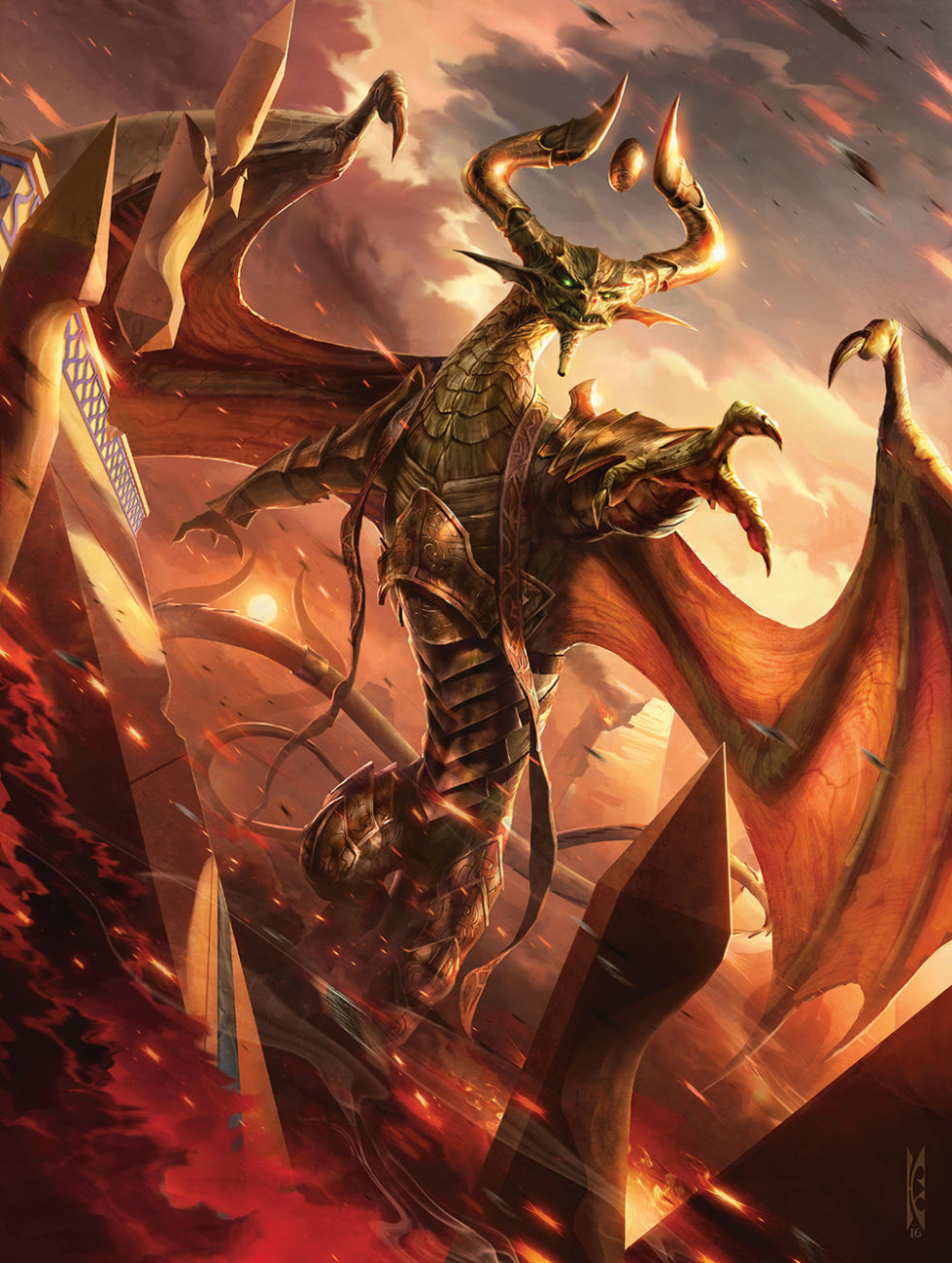
What happened to Amonkhet?
Hour of Devastation (HOU) is set on the world of Amonkhet (see our review of the original set for more info) as the prophesied “hours” arrive, momentous events that promised glory and eternal life. It turns out, though, that those events were the machinations of Nicol Bolas, the major antagonist of the set.
Introducing a new world and then bringing in conflict is a theme that has been repeated by Wizards of the Coast with the large/small set structure of Magic recently, so there’s not really a “twist” element to enjoy here, but the aesthetic execution is top-notch. The gleaming city has become a besieged, panicked landscape, with some classic dark Egyptian tropes taking centre stage—the river turning to blood, a plague of locusts, the marauding living dead. There’s also clever references to Amonkhet, with ruined versions of buildings seen on old cards turning up in the art for new cards.
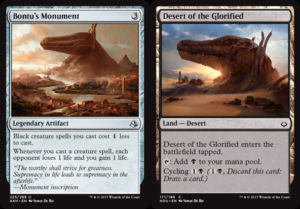
There’s also some more unusual themes to help Magic put its own stamp on the setting, especially around Nicol Bolas himself, who turns up in much of the set’s flavour text, generally expressing his contempt for all things that aren’t Nicol Bolas. Magic’s story continues to be surprisingly decent for a card game, and many of the cards depict key beats—the assault on the city, the slaying of the Gods we met last set, a new zombie army for Bolas, the “Eternals”—and there’s long-form stories that Wizards publish online for those who want more background.
The mechanics
Follow-up sets generally build on the first set mechanically, and HOU is no exception. Cycling and Exert are back, Eternalize is Embalm’s evil sibling, whilst Afflict is brand new. There’s also a bunch of cards that reference Deserts, a special type of land that showed up in Amonkhet, but had no previous mechanical relevance.
Cycling is a smooth continuation from the first set, allowing players to discard a card in exchange for a new one drawn from the deck, by paying a small cost. This has much the same effect on how fun the set is—more decision-making and less expensive cards “stuck” in the hand, which means more interesting games.

Exert, on the other hand, has evolved. Though it’s still the same from a rules standpoint—some creatures let you Exert them to get some sort of extra benefit, but in exchange aren’t available to use for your next turn—it’s no longer only the combat boosts we saw in Amonkhet. In HOU, we get creatures Exerting to produce extra mana, snipe your opponent’s creatures, or create extra token creatures for your side. This leads to more interesting decision-making than the Amonkhet version, which was often just “exert to attack, unless I can attack normally.” As another nice extension, there’s a set of cards where you effectively Exert yourself, getting a huge effect for a low cost, but denying you access to most of your mana next turn.
Featured in this cycle are the original Gods of Amonkhet, mostly being cruelly disposed of by Bolas now their roles are complete. As part of the assault on the city, three more Gods arrive, their original purpose and personality lost. Beautifully, these cards don’t even have names—what were once revered Gods of the plane are Bolas’ minions now.
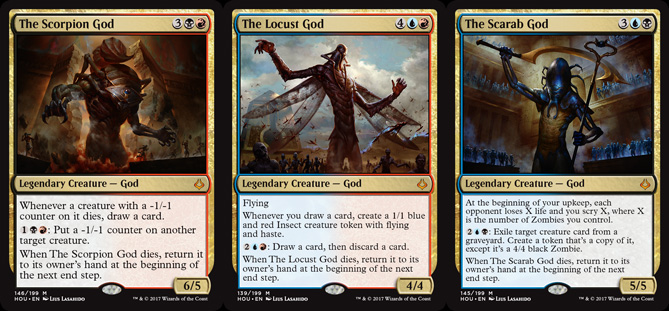
Afflict is meant to push home the general feeling of despair, but ends up falling a little flat. Afflict appears on many of the creatures serving Bolas, punishing someone who’s on the defensive, causing them to lose extra life even if the creature can’t make it through to the player. It’s not really frustrating to face down as the defensive deck, and pleasing to use in an aggressive deck, but compared to the rest of the set, it feels a little tacked-on and dull.
Eternalize is much more resonant, with Bolas building an advanced zombie army from the cream of the dead crops. Like Embalm, Eternalize cards can be played once from the graveyard, getting a second chance to fight for you, but unlike Embalm they get a hefty stat boost in exchange for an increased mana cost. Creatures brought back with Eternalize are always set to four power and four toughness, and often have abilities that take advantage of their bigger size.
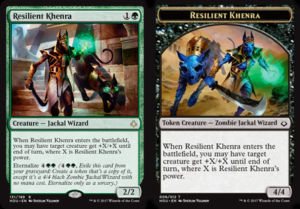
The capstone for Eternalize is the new set of zombie tokens (representing the resurrected minions) that can be collected from booster packs, depicting the unnaturally blue crystal-clad horrors with Egyptian-mythology-inspired adornments. Along with the mechanical implications—giving players something to do both early and late in a typical game of Magic—Eternalize is definitely the star of the set, and we’re glad to see it show up as a riff on Embalm.
The last mechanical theme is Deserts, a special subtype for lands. There’s a few cycles of Desert lands (two for each colour) that give you something else to do with spare lands—some that feature Cycling, some that allow you to sacrifice any Deserts (including themselves) for abilities often strong enough to turn round a game. There’s also a bunch of cards that reference Deserts, getting a small bonus if you have one in play or in the graveyard—a nice touch to prevent the feel-bad moment of sacrificing or cycling a Desert only to then draw a bunch of sweet Desert-loving camels. The low rarity and high count of these cards stops Deserts from feeling like they’ve just been tacked onto the set—most games will see a few show up and have an effect.
The one downside is that Deserts are a parasitic mechanic, undermining something about Magic that many love—combining cards from a variety of sets to create something powerful, or ridiculous, or both—as Deserts don’t have special interactions with older cards.
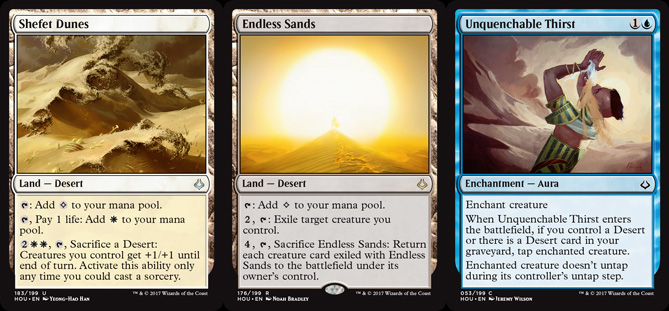
Is Hour of Devastation fun?
HOU features good, solid Magic gameplay, with a few twists to make it stand out. There’s a concerted effort to produce something for most types of player; sleek and efficient for the highly competitive, big and stompy for the hedonist, clever and weird for the experimental, flavourful for the lore nerd. The real victory of Cycling and Eternalize—together appearing on about 15% of the cards—is the smoothness they add to gameplay, preventing a few of those games where the inherent variance of a card game could have slipped away from fun into frustration.
With the evolution of Exert, a defensive strategy seems much more viable, allowing players to try out a variety of deck styles and in-game tactics, especially in the Limited formats, which we highly recommend as the way to play Magic. In Constructed formats, there is a bunch of power here to be discovered and explored over the next few months for Standard, but only a few potential tricks for the more niche Eternal formats.
Reader Comments (22)
View comments on forumLoading comments...